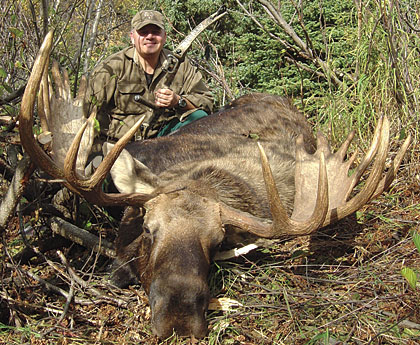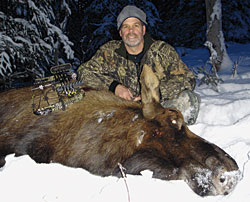October 28, 2010
By Tracy Breen
How to Bag Your Bull Without Breaking the Bank...
By Tracy Breen
 Veteran moose hunter Marc Taylor, author of the Hunting Hard in Alaska book series, poses with one of his numerous bow-killed bull moose. |
I speak at game dinners across the country, and over the years I've learned that most diehard hunters dream about bagging a bull moose. Some fantasize about hunting them in Alaska or the Yukon. Many would settle for hunting them in Maine, Idaho or Colorado. Regardless of where you hunt them, moose are extremely large and have huge antlers on their head. Not surprisingly, that makes them very popular with bowhunters.
Do It Yourself
The problem is, moose hunting can be expensive. The average cost of a guided moose hunt in Alaska is $8,000-$12,000 or more! However, if you have big dreams of chasing moose and a small checking account, you can still make your dreams come true with a little research and plenty of effort. To succeed, you must invest as much effort into planning your hunt as you will hunting.
Advertisement
Ohio hunter Paul Williams killed his Alaska bull in 2008 and only spent a few thousand dollars on the hunt. "The most expensive part was renting a vehicle," he said. "My lodging and meals were inexpensive, and I didn't have the cost of a float plane trip. So, my hunt was a low-budget affair."
Williams hunted moose on Fort Richardson in Anchorage. Each year, the U.S. Army holds a primitive weapon hunt where hunters can use a muzzleloader or bow. They offer fall and early-winter hunts, and the toughest thing is simply drawing the tag.
Advertisement
"There isn't a preference point system, so getting drawn is tough," Williams said. "I always wanted to hunt in Alaska, and I figured the Army base hunt would be the least expensive way."
Williams was right. A single floatplane drop-off can cost $2,000 or more. But every day, Williams was able to drive from where he was staying to the base and go hunting. "It was great," he said. "No expensive planes or outfitters were needed."
 Being flown into the bush on a floatplane is expensive, but your chances of success increase significantly if you can access a lightly hunted area. |
The disadvantage was he drew the late-season tag and shot a bull that had lost its antlers. One day while hunting, Williams spotted a cow moose and decided to stalk the cow for practice. "As I got closer, I glassed it and saw it was a bull that had lost his antlers," he said. "I sat there and wondered what I should do. It was a bull." Williams decided if the bull walked out in the open and gave him a broadside shot, he would shoot it. That's exactly what happened. "I made a good hit on the bull and was very pleased. It was a great experience, and I hope to do it again."
Marc Taylor has also hunted moose on Fort Richardson. Taylor now lives in Alaska and owns a Wiggy's Sleeping Bag Store in Anchorage. He has hunted all over the state. "I have drawn the Fort Richardson moose tag several times, but hunters who want to hunt moose shouldn't plan to get that tag because it is hard to draw. They should plan a backcountry trip and do what they can to save money," he said.
Taylor has written a book series titled Hunting Hard in Alaska. He believes hunters wanting to hunt in Alaska should plan a trip at least a year in advance. "Alaska is a big place, and hunters looking to come here should start by researching where to go months in advance," he suggested. "Finding a good flying service to fly them in and drop them off is vital. The chances of getting a bull by walking in from the road are slim. Serious hunters should plan to pay to be flown into the bush. To locate a good fly-in service, do some research. Books and the Alaska Hunting Forum are good places to start. Posting questions about flying services on a forum will often get responded to by hunters who are willing to provide good and bad fly in companies."
 Ohio bowhunter Paul Williams killed this bull moose that had shed its antlers at Fort Richardson in Anchorage, Alaska, where the Army holds a primitive hunt each year. Although the odds of drawing a tag for Fort Richardson are low, the odds of success for those who do are high. |
If you plan to go to Alaska, you need to find the right place to hunt. When looking at a map, remember some units have antler restrictions and some don't. A few years ago, I hunted in a unit without antler restrictions, which made hunting more fun because I didn't have to worry whether the bull was big enough to be legal. In some units, a bull's rack must be 50 inches wide or wider. If you shoot a 49-inch bull, you are in trouble.
When researching areas, calling a biologist is a good way to get information. Dave Battle grew up in North Carolina and moved to Alaska. He regularly called biologists during his first few years in the state. "Biologists can give you information about the trophy potential of the animals in the units they oversee, as well as moose density in their areas, which can help you narrow down your search," Battle explained.
Twelve years ago, my dad hunted in Alaska and arrowed a Pope and Young bull on his first day of the hunt. He and my cousin were dropped off on a river system, and within 24 hours, they were both tagged out. The key to their success was long-distance scouting. My dad called several fly-in services, outfitters and others to locate a good drop-off location and hunting area. Today, you only need the Internet! Spending time online researching areas, looking at fish and game Web sites and networking with other hunters on forums will easily help you find a good place to hunt. You must act like a detective looking for clues. The more time you have to research and search for clues, the better your hunt will turn out.
Tags, Teepees and Tactics
If hunting Alaska on your own isn't for you, consider hunting moose in the Lower 48. Many Western states have Shiras Moose. You can also hunt Canada moose in Maine, New Hampshire and Vermont. The Yukon Moose in Alaska are the largest subspecies, but in the Lower 48, bush planes are not needed, which greatly reduces the cost of the hunt. If you want to hunt moose in the Western states, remember that the tag fees are extreme. A moose tag in Idaho
, for example, is over $2,000. However, an Idaho moose hunt would still cost less than hunting in Alaska when you factor in floatplane costs.
If hunting moose in the West sounds like fun, consider buying a subscription to The Huntin' Fool magazine, which breaks down the drawing process in all 13 Western states, species by species. Hunters must draw a tag in order to moose hunt. "Moose hunting in the West is more reasonable than hunting in Alaska. In some units, getting drawn isn't going to take years," said Huntin' Fool's Garth Carter. "There are some units in Idaho that have leftover tags."
Regardless of location, a moose hunt will test you physically and mentally, especially if you are doing everything yourself. "Quartering a moose and packing it out is a lot of work," Taylor said. "Hunters need to be in shape if they come to hunt moose. Having good gear is also important. The weather can be extreme in the West and in Alaska. Having a top-notch sleeping bag, tent and backpack is key."
 Although outfitted moose hunts can run $10,000 or more, hunters willing to do their own research and planning can often fulfill dreams of big bulls for only a third of that price. |
Taylor and many other hunters who spend significant time in the backcountry use lightweight teepees that come with a collapsible wood stove. I use a Kifaru (www.kifaru.net) teepee. Taylor uses a similar unit made by Titanium Goat (www.titaniumgoat.com). "A lightweight teepee is durable and packs into a small bag, which is important when packing in. When flying in, you need lightweight gear because float planes have weight restrictions."
Moose are not the brightest bulbs in the closet. They will often walk within bow range if the hunter is a decent caller. "In the rut, a bull will come running up to the sound of a cow moan, which makes moose a bowhunter's dream come true," Taylor said. When Taylor says they will get close, he means it. My dad's moose walked within eight yards of him after dad spent a few minutes brushing trees with a stick and grunting like a bull.
If you are a hunter on a budget like mine, the best way to hunt several big-game animals is by putting in for tags. Whether you plan to hunt in Alaska, Maine or Idaho, if you draw a limited-entry tag, your chances of going on a low-budget hunt and tagging a big bull increase dramatically. For example, the odds of drawing a Fort Richardson moose tag are less than 5 percent. But if you draw, you have the equivalent of a Wal-Mart moose hunt. If you don't put in for the Fort Richardson tag because the odds of getting it are small, your chances of getting a bull are zero. "I have drawn that tag four times, which is crazy when you consider the odds," Taylor noted. "I have shot some great bulls; one that was 58 inches wide." While putting in for the tag in Alaska, put in for Western moose tags and Maine moose tags too. Eventually, you will get lucky. In Maine, you can even buy extra draws to increase your odds.
The Bottom Line
My 2008 moose hunt cost about $2,500. My dad's was $3,500 in 1997. Paul Williams said he spent less than $3,000 on his hunt. If you pinch pennies, even with the cost of being dropped off in the bush, you can hunt moose for less than $4,000 in Alaska and even less in the Lower 48.
If you want to save even more money, get an Alaska Airlines credit card. I put everything I buy on this card and earn free airline tickets. I have hunted and fished in Alaska twice in the last two years. I have never paid for my airfare, which saved me $800-$1,000 on each trip.
If you want to hunt moose, do lots of research, get in shape and practice your calling. You may find yourself staring at a bull eight yards away.
